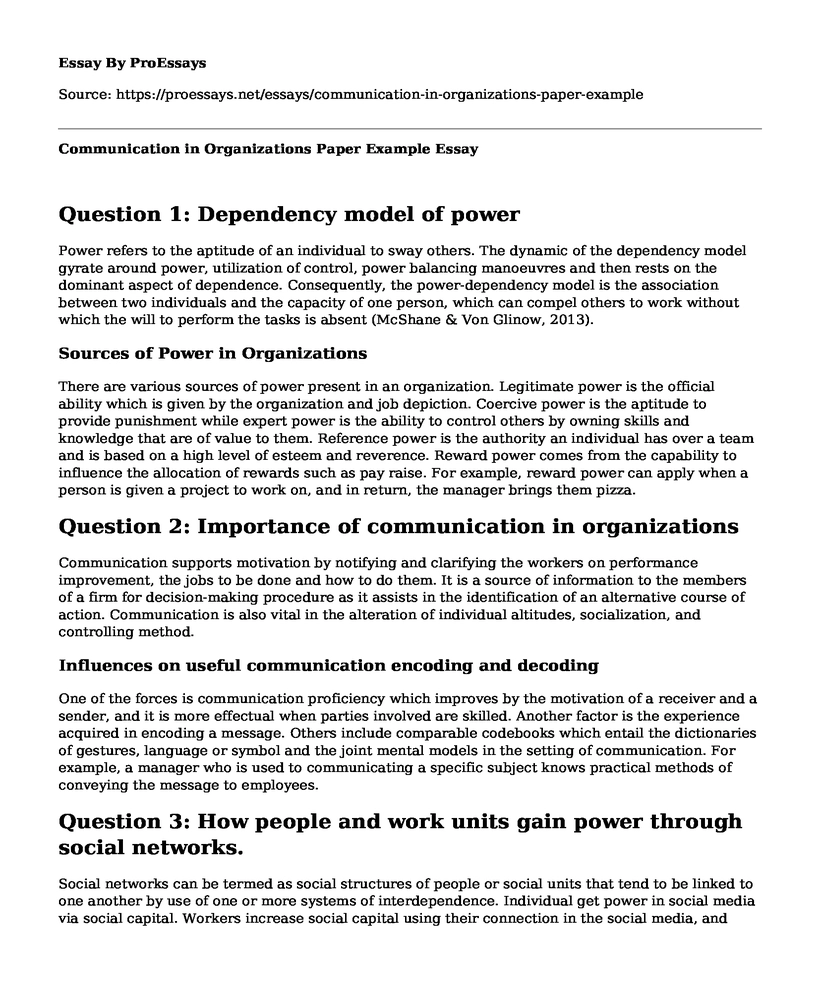Question 1: Dependency model of power
Power refers to the aptitude of an individual to sway others. The dynamic of the dependency model gyrate around power, utilization of control, power balancing manoeuvres and then rests on the dominant aspect of dependence. Consequently, the power-dependency model is the association between two individuals and the capacity of one person, which can compel others to work without which the will to perform the tasks is absent (McShane & Von Glinow, 2013).
Sources of Power in Organizations
There are various sources of power present in an organization. Legitimate power is the official ability which is given by the organization and job depiction. Coercive power is the aptitude to provide punishment while expert power is the ability to control others by owning skills and knowledge that are of value to them. Reference power is the authority an individual has over a team and is based on a high level of esteem and reverence. Reward power comes from the capability to influence the allocation of rewards such as pay raise. For example, reward power can apply when a person is given a project to work on, and in return, the manager brings them pizza.
Question 2: Importance of communication in organizations
Communication supports motivation by notifying and clarifying the workers on performance improvement, the jobs to be done and how to do them. It is a source of information to the members of a firm for decision-making procedure as it assists in the identification of an alternative course of action. Communication is also vital in the alteration of individual altitudes, socialization, and controlling method.
Influences on useful communication encoding and decoding
One of the forces is communication proficiency which improves by the motivation of a receiver and a sender, and it is more effectual when parties involved are skilled. Another factor is the experience acquired in encoding a message. Others include comparable codebooks which entail the dictionaries of gestures, language or symbol and the joint mental models in the setting of communication. For example, a manager who is used to communicating a specific subject knows practical methods of conveying the message to employees.
Question 3: How people and work units gain power through social networks.
Social networks can be termed as social structures of people or social units that tend to be linked to one another by use of one or more systems of interdependence. Individual get power in social media via social capital. Workers increase social capital using their connection in the social media, and social capital tends to augment according to the network ties present. Also, strong links have the aptitude to upsurge social capital since the connections offer extensive resources rapidly. The centrality of the network is determined by various methods, comprising the degree to which a person is situated between other people in the network, the number of ties tying the individuals and the closeness of the relationship. By building the fabric of the personal system, an individual gets resources, insight, and support thus increasing his power. For instance, when a politician has several friends on social media, contributes to posts and engages with them, he builds strong ties that help him gain more power.
Question 4: Contingencies of power
The interpretation of power into impact over the results of an organization takes place merely under certain circumstances referred to as contingencies of power. Power does, however, not originate from these contingencies but they play a role in determining the degree to which people can leverage possessed power for purposes of making things happen in an organization. Substitutability is one of the contingencies, and it pertains to the obtainability of alternatives. Power tends to be strong when an individual has a monopoly over a significant resource that does not have substitutes. On the other hand, as the number of alternatives sources of the critical resource augments, the power lessens. Centrality is the extent and nature of interdependence existing between power holders and other people. Discretion is the liberty to exercise verdict or make decision devoid of referring to a particular rule. Visibility is the degree to which a person holding power is recognized. For instance, in the case of clarity, when an employee presents an idea for a probable client to his boss, then the boss owns it after submitting it to the manager.
Reference
McShane, S. L., & Von Glinow, M. A. (2013). Organizational behavior: Emerging knowledge, global reality (6th ed.). New York, NY: McGraw-Hill/Irwin
Cite this page
Communication in Organizations Paper Example. (2022, Jun 20). Retrieved from https://proessays.net/essays/communication-in-organizations-paper-example
If you are the original author of this essay and no longer wish to have it published on the ProEssays website, please click below to request its removal:
- Paper Example on Mergers and Acquisitions
- Essay Sample on The Plight of the Minority Battered Woman/Survival Studies
- Essay Example on Intercultural Communication: Exchanging Verbal & Nonverbal Modes
- Essay Sample on Role of Port Facility Security Officer (FSO) in Port Security
- Essay Example on High Performance Leadership: The Managerial Grid of Bill Gates
- Essay Example on Pegasus: Technology Leadership in New Millennium
- Sustainable Bus. Mgmt: Interaction & Certificatory Practice for Firms' Impact - Essay Sample







